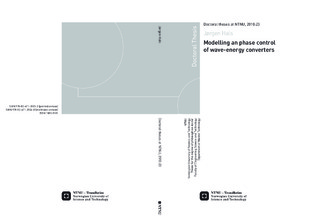| dc.contributor.author | Hals, Jørgen | nb_NO |
| dc.date.accessioned | 2014-12-19T12:06:19Z | |
| dc.date.available | 2014-12-19T12:06:19Z | |
| dc.date.created | 2011-02-03 | nb_NO |
| dc.date.issued | 2010 | nb_NO |
| dc.identifier | 403616 | nb_NO |
| dc.identifier.isbn | 978-82-471-2003-3 (printed ver.) | nb_NO |
| dc.identifier.isbn | 978-82-471-2004-0 (electronic ver.) | nb_NO |
| dc.identifier.uri | http://hdl.handle.net/11250/237872 | |
| dc.description.abstract | Current prognoses are that, unless counteracted by very strong political measures, the world will meet both energy shortage and climate crisis within a horizon of a few decades, both of which are strongly related to our dependence on fossil fuels. Renewable energy sources may be harvested sustainably, and developing technology for their exploitation therefore forms an obvious part of strategies to reduce emissions and secure energy supply.
Wave energy is a resource with relatively high power density, readily available along the coasts, and thus coinciding with the areas where industry and people tend to be accumulated. In some regions this resource is large enough to form a significant part of the energy mix. The technology for harnessing the power of ocean waves is today still on the research and development stage. The challenge is to make a design where the costs of investment, operation and maintenance (in terms of money, resources and energy) can be justified by the availability and potential earnings.
This thesis focuses on two aspects of systems for wave energy conversion: How to model such systems, which is important for understanding and design, and how to control their motion, which is crucial for the primary power conversion – the inevitable step that forms the basis for revenues and energy output from such a device. The dissertation is based on articles published in scientific conferences and journals, as well as an account for background of the undertaken research and the methods used.
The bond graph modelling language has been chosen as a promising aid for the modelling of the power converter dynamics. It enables a systematic and transparent approach to the path from drawing board to mathematical equations. Examples show how energy conversion systems may be modelled and simulated within this framework. These include heave-motion models for a semi-submerged sphere, a platform/buoy two-body system and a smallscale oscillating water column (OWC), as well as wave-to-wire models of two made-up systems. The OWC model was also studied by laboratory experiments.
A range of control strategies has been studied and compared by numerical simulation, and in one case also by laboratory experiments. These strategies include phase control by latching and by clutching, approximations to complex-conjugate control, and model predictive control (MPC). Constraint handling and real-time parameter tuning are discussed, too. The constrained optimal power absorption is investigated, and for the example of a semi-submerged heaving sphere in irregular waves it is found that MPC in combination with a Kalman filter predictor is able to provide an absorbed power in excess of 90% as compared to the non-causal (and hence not completely realisable) constrained optimum.
Other causal controller implementations gives an absorbed power ranging from 10 to 90% of that achieved with MPC. The best performing control strategies, however, involve a large flow of reactive power through the machinery, which in normal irregular-wave operation may give peak-to-average power ratio as high as 25 and above. This represents a challenge to the design of machinery and controller.
An interesting observation from the numerical simulations is the possibility of increased absorbed power in irregular waves as compared to regular waves having about the same wavelength characteristics and the same wave power level. An explanation is suggested for this phenomenon. | nb_NO |
| dc.language | eng | nb_NO |
| dc.publisher | Norges teknisk-naturvitenskapelige universitet, Fakultet for ingeniørvitenskap og teknologi, Institutt for marin teknikk | nb_NO |
| dc.relation.ispartofseries | Doktoravhandlinger ved NTNU, 1503-8181; 2010:23 | nb_NO |
| dc.relation.haspart | Engja, H.; Hals, J.. Modelling and simulation of sea wavepower conversion systems. Proceedings of the 7th European Wave and Tidal Energy Conference,, 2007. | nb_NO |
| dc.relation.haspart | Hals, Jørgen; Taghipour, Reza; Moan, Torgeir. Dynamics of A Force-Compensated Two-Body Wave Energy Converter in Heave with Hydraulic Power Take-Off Subject To Phase Control. Proceedings of the 7th European Wave and Tidal Energy Conference, 2007. | nb_NO |
| dc.relation.haspart | Lopes, M. F. P.; Hals, J.; Gomes, R. P. F.; Moan, T.; Gato, L. M. C.; Falcao, A. F. de O.. Experimental and numerical investigation of non-predictive phase-control strategies for a point-absorbing wave energy converter. Ocean Engineering. (ISSN 0029-8018). 36(5): 386-402, 2009. <a href='http://dx.doi.org/10.1016/j.oceaneng.2009.01.015'>10.1016/j.oceaneng.2009.01.015</a>. | nb_NO |
| dc.relation.haspart | Hals, Jørgen; Falnes, Johannes; Moan, Torgeir. Constrained Optimal Control of a Heaving Buoy Wave-Energy Converter. Journal of Offshore Mechanics and Arctic Engineering-Transactions of The Asme. (ISSN 0892-7219). 133(1): 011401, 2011. <a href='http://dx.doi.org/10.1115/1.4001431'>10.1115/1.4001431</a>. | nb_NO |
| dc.relation.haspart | Hals, J; Falnes, J; Moan, T. A comparison of selected strategies for adaptive control of wave energy converters.. Journal of Offshore Mechanics and Arctic Engineering-Transactions of The Asme. (ISSN 0892-7219), 2011. | nb_NO |
| dc.title | Modelling and phase controlof wave-energy converters | nb_NO |
| dc.type | Doctoral thesis | nb_NO |
| dc.contributor.department | Norges teknisk-naturvitenskapelige universitet, Fakultet for ingeniørvitenskap og teknologi, Institutt for marin teknikk | nb_NO |
| dc.description.degree | PhD i marin teknikk | nb_NO |
| dc.description.degree | PhD in Marine Technology | en_GB |

